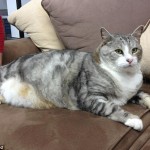When Sumo the cat was brought into the RSPCA last week he became the fattest cat to have waddled through their doors for decades.
‘He is the biggest cat I’ve ever seen and I’ve been a vet for 45 years,’ said Vicki Lomax, RSPCA veterinarian who works at the Wacol RSPCA in Brisbane where Sumo was brought in.
Tipping the scales at 14.3kg, the nine-year-old ordinary domestic short hair weighs almost three times what he should.

The nine-year-old cat is being cared for by Tanya Boland and her daughter Aislynne (pictured) for a month. Tanya is a vet nurse form the RSPCA and has put him on a special diet

Sumo, held here by Tanya Boland, is at risk of diabetes, as well as heart, liver and kidney disease and arthritis
‘For a cat like him, 5 to 6 kg would probably be a reasonable weight,’ said Ms Lomax.
Sumo came to the RSPCA because his owners were moving house and could not take him with them.
When he was brought to the RSPCA centre staff decided to name him and settled, for obvious reasons, on Sumo.
As with humans, Ms Lomax said, pets get overweight from a combination of overfeeding and lack of exercise.
‘Cats can be very persistent, there are cats that will follow you to the fridge and more or less demand food. There are owners who have trouble saying no, I guess it’s like parents saying no to the kids,’ said Ms Lomax.
‘Overweight cats are pretty much subject to the same problems we have when we’re overweight,’ said Ms Lomax.
Some of the dangers to Sumo’s health posed by his size include heart and kidney disease, diabetes, muscle atrophy, and arthritis.
Sumo is currently being fostered by one of the vet nurses at the RSPCA, Tanya Boland.
She has put Sumo on a strict diet, he is now fed less than two cups of low- calorie dry cat food per day.
On his new diet, Sumo should lose about 250g per week, which would put him on track to be a much healthier animal.
Though his weight loss will present an interesting challenge to the RSPCA vets.
‘I’m not sure what we’re going to do with all his skin when he’s done, he might need a nip and a tuck,’ said Ms Lomax. ‘I’m sure we can find a vet who can deal with it.’
HOW TO TELL IF YOUR CAT IS TOO FAT AND WHAT TO DO ABOUT IT
To tell if your cat has packed on a few too many pounds, Vicki Lomax says you should feel the skin over their ribs.
‘If it’s difficult to feel their ribs, that usually means the cat is overweight,’ she said.
Owners should also weigh their cats – either at the vets or by holding their cats and subtracting their own weight from the total – to see if weight loss is working.
To make sure you’re not overfeeding your cat, check the back of the pet food packet and compare the recommended serve with how much your cat eats.
‘If you’re feeding it too much, you should feed it what the packet says. If that doesn’t work, you should decrease the amount the cat’s being fed by 25 percent,’ recommends Ms Lomax.
If owners don’t see a change after a month, Ms Lomax recommends taking the cat to the vet, where the vet can check for hormonal problems or recommend a special diet.

The cat weighs 14.3kg, almost three times its ideal weight of five to six kg








 Photographer Finds Locations Of 1960s Postcards To See How They Look Today, And The Difference Is Unbelievable
Photographer Finds Locations Of 1960s Postcards To See How They Look Today, And The Difference Is Unbelievable  Hij zet 3 IKEA kastjes tegen elkaar aan en maakt dit voor zijn vrouw…Wat een gaaf resultaat!!
Hij zet 3 IKEA kastjes tegen elkaar aan en maakt dit voor zijn vrouw…Wat een gaaf resultaat!!  Scientists Discover 512-Year-Old Shark, Which Would Be The Oldest Living Vertebrate On The Planet
Scientists Discover 512-Year-Old Shark, Which Would Be The Oldest Living Vertebrate On The Planet  Hus til salg er kun 22 kvadratmeter – men vent til du ser det indvendigt
Hus til salg er kun 22 kvadratmeter – men vent til du ser det indvendigt  Superknepet – så blir snuskiga ugnsformen som ny igen!
Superknepet – så blir snuskiga ugnsformen som ny igen!  Meteorite That Recently Fell in Somalia Turns Out to Contain Two Minerals Never Before Seen on Earth
Meteorite That Recently Fell in Somalia Turns Out to Contain Two Minerals Never Before Seen on Earth  Nearly Frozen Waves Captured On Camera By Nantucket Photographer
Nearly Frozen Waves Captured On Camera By Nantucket Photographer  It’s Official: Astronomers Have Discovered another Earth
It’s Official: Astronomers Have Discovered another Earth 